What should I expect?
Nonsurgical Rehabilitation
After suffering from an elbow dislocation that does not require surgery, your arm may be immobilized for 10 to 14 days to allow the ligaments to heal. Intermittent gentle range of motion (ROM) and basic muscle tightening exercises (isometric exercises) with your arm out of the sling may be allowed during this time but you should rely on your physician to advise you whether this is suitable in your case. The type of activities and movements allowed are determined according to the extent of injury that is present.
Physical therapy at STAR Physical Therapy can begin as soon as you are allowed to start ROM exercises or as soon as your doctor advises it.
When the sling is removed, you will experience some pain when you start to move your elbow and forearm. This pain is from not using the joints regularly over the period of immobilization and also commonly from concurrent soft tissue injury that occurred when you dislocated your elbow. Your therapist will assess how much soft tissue injury is present by testing the stability of your ligaments as your elbow tolerates it. Unfortunately with a lot of ligament damage, your elbow is at risk of frequently dislocating or being unstable. If a lot of scar tissue builds up, however, the elbow will become too stiff and this affects the normal functioning of the joint. The elbow joint is particularly sensitive to injury and easily becomes stiff.
Your treatment at STAR Physical Therapy will focus initially on relieving any pain or swelling you may have. Your therapist may use modalities such as heat, ice, ultrasound, or electrical current to assist with decreasing any pain or swelling you have around your elbow or anywhere along the forearm, at the shoulder, or into your hand. Your therapist may also use massage for your neck, shoulder, elbow, forearm, or wrist to improve circulation, assist with the pain, and make moving the entire upper extremity easier.
The next part of our treatment will focus on regaining the ROM, strength, and overall function of your elbow. Most elbows are stiff after a period of immobilization, but one of the main goals of immobilizing the elbow is to allow the ligaments to heal as scar tissue forms. With scar tissue in place the joint regains some of its stability, but stiffness is to be expected. If you have also lost ROM in your wrist, hand, or shoulder due to the period of immobilization or due a concurrent injury, exercises will also be prescribed for these joints. If your elbow is particularly stiff, your therapist may suggest you work on the range of motion in a pool where the water properties of warmth, buoyancy, and hydrostatic pressure often make it easier and less painful to move your joint.
Your physical therapist at STAR Physical Therapy will prescribe a series of stretching and strengthening exercises that you will practice in the clinic and also learn to do as part of a home exercise program. These exercises may include the use of light weights or exercise tubing to add resistance for your elbow, wrist and shoulder. Soft balls or gripping devices may be used to encourage the return of your grip strength. Regularly measuring your grip strength with a hand-held dynamometer will be one of the ways we determine the progress of your rehabilitation at STAR Physical Therapy.
If necessary, your physical therapist will mobilize your joints. This hands-on technique encourages the stiff joints of your elbow, and wrist or shoulder (if necessary) to move gradually into their normal ROM. Early mobilization and ROM exercises are particularly important in the rehabilitation of the elbow. Without these types of exercises an elbow that has been dislocated can quickly become too stiff and lose important ROM, which may be difficult to gain back over a longer period of time. Regaining the ability to bend your elbow and rotate your forearm is crucial in order to be able to do simple daily activities such as bringing food to your mouth or to hold change in your hand. Regaining elbow extension (straightening), while also important, is not as crucial to the activities of daily living in comparison to elbow flexion. In other words, losing some straightening of the elbow due to stiffness following an elbow dislocation will not affect your everyday function as much as the loss of a lot of elbow flexion. That being said, for those participating in sport, loss of any elbow extension can be extremely detrimental to the functioning of their upper limb and can severely limit them in their sport. For this reason, the return of full elbow range of motion, in any situation, is one of the goals of physical therapy at STAR Physical Therapy. Your therapist will keep a close watch on the improvements in your ability to bend and straighten your elbow as well as rotate your forearm by measuring these angles repeatedly over the course of your rehabilitation.
As a result of any injury, the receptors in your joints and ligaments that assist with proprioception (the ability to know where your body is without looking at it) decline in function. A period of immobility will add to this decline. Even an activity such as assisting yourself with your arms to get out of a chair, pulling a glass from a cupboard, or pushing a door open requires weight to be transmitted through your elbow and for your body to be proprioceptively aware of your limb. If you are an athlete, then proprioception of your upper extremity is paramount in returning you to your sport after an elbow dislocation. For this reason proprioceptive exercises will be an important part of your rehabilitation program at STAR Physical Therapy. Proprioceptive exercises might include activities such as rolling a ball on a surface with your hand, holding a weight up overhead while bending and straightening your elbow, or push-ups on an unstable surface. Advanced exercises may include activities such as throwing or catching a ball. For athletes we will encourage exercises that mimic the quick motions of the sports or activities that you participate in. Proprioceptive exercises for the shoulder blade may also be included, as this area of the upper extremity needs to be well controlled in order for the elbow to function optimally. The shoulder area is the elbow’s connection to the torso and creates a stable base for the elbow to work from. For this reason maximum control of the shoulder is extremely important in order to optimize your elbow function.
If your elbow dislocation results in an elbow that is too loose, or unstable, rehabilitation will focus even more around controlling the elbow joint using the muscles around the elbow and the shoulder. Very extensive and advanced proprioceptive exercises will be prescribed along with several strengthening exercises. Taping and bracing (as discussed below) can assist with keeping the joint stable. Your therapist will educate you on common activities that can re-dislocate your elbow, and these activities should be strictly avoided. Minor to moderate laxity can usually be well controlled with physical therapy. Severe laxity will likely require surgical intervention.
In addition to specific exercises for your elbow and upper limb, we highly recommend maintaining the rest of your body’s fitness with regular exercise while you rehabilitate your elbow. Maintaining general cardiovascular fitness can be done with lower extremity fitness activities such as walking or using a stationary bike or stepper machine. Weights for your other arm or lower extremities can also be done but you may require a friend to assist you in the gym as no weight should be lifted by your injured elbow until the tissues have had a chance to heal, and your therapist allows it. In fact, while your elbow is healing it is best to avoid any further traction on it at all. Pulling a door open, carrying a heavy purse in the crux of your elbow, or lifting a weighted backpack are a few examples of activities and movements that put a traction force through the elbow. Your therapist may use these traction-type activities as your therapy advances in order to strengthen your elbow and prepare it for everyday use. Early on, however, it is best to avoid them.
Your therapist will add graduated heavier exercises and endurance work as soon as your elbow can tolerate it. Following the strict advice of your therapist when adding or advancing exercises is necessary as it is crucial to ensure these stresses can be withstood by the elbow before returning to any heavy work duties or sporting activities.
Some athletes or workers with manual jobs continue to wear a protective splint and/or use taping to stabilize the joint during the transition back into action. A brace or tape can help protect the joint during motion and activity and can add to the proprioceptive control you feel around your joint. Your physical therapist can educate you on which type of brace would be best for you and can tape your elbow to simulate a brace before you buy one, or instead of buying one.
Generally, elbow dislocations respond extremely well to the physical therapy we provide at STAR Physical Therapy. Simple elbow dislocations generally heal well with few (if any) problems. Unfortunately however, a consequence of an elbow dislocation is that osteoarthritis of the joint can occur years down the track. With uncomplicated elbow dislocations that do not require surgery most athletes can resume some sports participation three to six weeks after the injury. The timing of return to work and sport depends on the type of work or sport (e.g., throwing sports or heavy labourers may require a longer rehab). In addition, dislocation of the dominant hand may require longer rehab before full motion and strength are restored.
STAR Physical Therapy provides services for physical therapy in Fairport and Rochester.
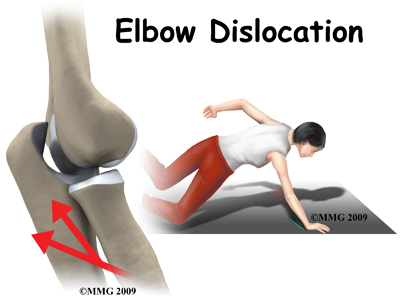 When the joint surfaces of an elbow are forced apart, the elbow is dislocated. The elbow is the second most commonly dislocated joint in adults (after shoulder dislocations). Elbow dislocations can be complete or partial. A partial dislocation is referred to as a subluxation. The amount of force needed to cause an elbow dislocation is enough to cause a bone fracture at the same time. These two injuries (fracture-dislocation) often occur together.
When the joint surfaces of an elbow are forced apart, the elbow is dislocated. The elbow is the second most commonly dislocated joint in adults (after shoulder dislocations). Elbow dislocations can be complete or partial. A partial dislocation is referred to as a subluxation. The amount of force needed to cause an elbow dislocation is enough to cause a bone fracture at the same time. These two injuries (fracture-dislocation) often occur together.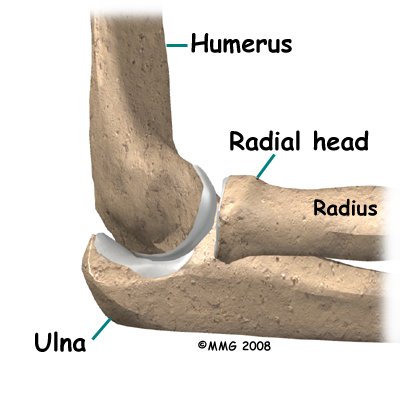 The elbow itself is essentially a hinge joint, meaning it bends and straightens like a hinge. Most people don’t realize that there is a second joint where the end of the radius (the radial head) meets the humerus. This joint is complicated because the radius has to rotate so that you can turn your hand palm up and palm down. At the same time, it has to slide against the end of the humerus as the elbow bends and straightens. The joint is even more complex because the radius has to slide against the ulna as it rotates as well. As a result, the end of the radius at the elbow is shaped like a smooth knob with a cup at the end to fit on the end of the humerus. The edges are also smooth where it glides against the ulna.
The elbow itself is essentially a hinge joint, meaning it bends and straightens like a hinge. Most people don’t realize that there is a second joint where the end of the radius (the radial head) meets the humerus. This joint is complicated because the radius has to rotate so that you can turn your hand palm up and palm down. At the same time, it has to slide against the end of the humerus as the elbow bends and straightens. The joint is even more complex because the radius has to slide against the ulna as it rotates as well. As a result, the end of the radius at the elbow is shaped like a smooth knob with a cup at the end to fit on the end of the humerus. The edges are also smooth where it glides against the ulna.

 There is also another important ligament called the annular ligament that wraps around the radial head and holds it tight against the ulna. The word annular means ring-shaped. The annular ligament forms a ring around the radial head as it holds it in place. This ligament can be torn when the entire elbow or just the radial head is dislocated.
There is also another important ligament called the annular ligament that wraps around the radial head and holds it tight against the ulna. The word annular means ring-shaped. The annular ligament forms a ring around the radial head as it holds it in place. This ligament can be torn when the entire elbow or just the radial head is dislocated.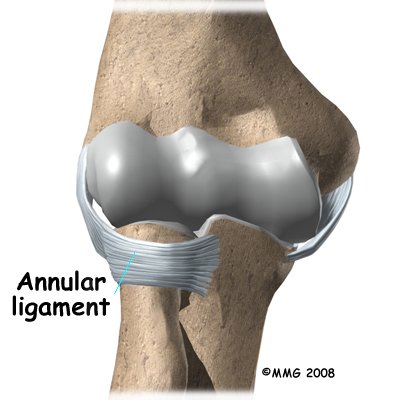
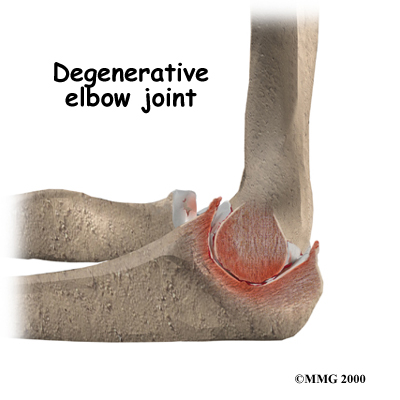 Elbow dislocation is usually the result of trauma. The most common trauma resulting in an elbow dislocation is a fall onto an outstretched arm and hand. For example, if you are pushed over you naturally try to break your fall by putting your hand out onto the ground. When the hand hits the ground, the force is transmitted through the forearm to the elbow. This force pushes the elbow out of its socket. This injury can also result in a fracture-dislocation.
Elbow dislocation is usually the result of trauma. The most common trauma resulting in an elbow dislocation is a fall onto an outstretched arm and hand. For example, if you are pushed over you naturally try to break your fall by putting your hand out onto the ground. When the hand hits the ground, the force is transmitted through the forearm to the elbow. This force pushes the elbow out of its socket. This injury can also result in a fracture-dislocation.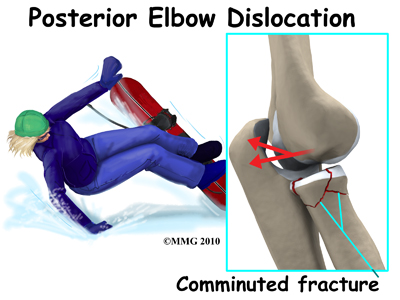

 If the elbow is fully dislocated, it will look out of joint. There may be dimples or indentations of the skin over the dislocation where the bones have shifted position. Pain can be intense until the arm is relocated. The pain is often significantly relieved immediately after the joint is put back in place but there will be residual tenderness around the joint.
If the elbow is fully dislocated, it will look out of joint. There may be dimples or indentations of the skin over the dislocation where the bones have shifted position. Pain can be intense until the arm is relocated. The pain is often significantly relieved immediately after the joint is put back in place but there will be residual tenderness around the joint. Pain and an inability to straighten the elbow or pain when turning the palm up (supination) is typical. There is often tenderness along the lateral aspect of the elbow (side of the elbow away from the body).
Pain and an inability to straighten the elbow or pain when turning the palm up (supination) is typical. There is often tenderness along the lateral aspect of the elbow (side of the elbow away from the body).